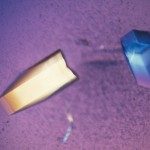Lien vers Pubmed [PMID] – 11827479
J. Mol. Biol. 2002 Feb;315(5):1099-110
Bacterial cytidine monophosphate (CMP) kinases are characterised by an insert enlarging their CMP binding domain, and by their particular substrate specificity. Thus, both CMP and 2′-deoxy-CMP (dCMP) are good phosphate acceptors for the CMP kinase from Escherichia coli (E. coli CMPK), whereas eukaryotic UMP/CMP kinases phosphorylate the deoxynucleotides with very low efficiency. Four crystal structures of E. coli CMPK complexed with nucleoside monophosphates differing in their sugar moiety were solved. Both structures with CMP or dCMP show interactions with the pentose that were not described so far. These interactions are lost with the poorer substrates AraCMP and 2′,3′-dideoxy-CMP. Comparison of all four structures shows that the pentose hydroxyls are involved in ligand-induced movements of enzyme domains. It also gives a structural basis of the mechanism by which either ribose or deoxyribose can be accommodated. In parallel, for the four nucleotides the kinetic results of the wild-type enzyme and of three structure-based variants are presented. The phosphorylation rate is significantly decreased when either of the two pentose interacting residues is mutated. One of these is an arginine that is highly conserved in all known nucleoside monophosphate kinases. In contrast, the other residue, Asp185, is typical of bacterial CMP kinases. It interacts with Ser101, the only residue conserved in all CMP binding domain inserts. Mutating Ser101 reduces CMP phosphorylation only moderately, but dramatically reduces dCMP phosphorylation. This is the first experimental evidence of a catalytic role involving the characteristic insert of bacterial CMP kinases. Furthermore, this role concerns only dCMP phosphorylation, a feature of this family of enzymes.

